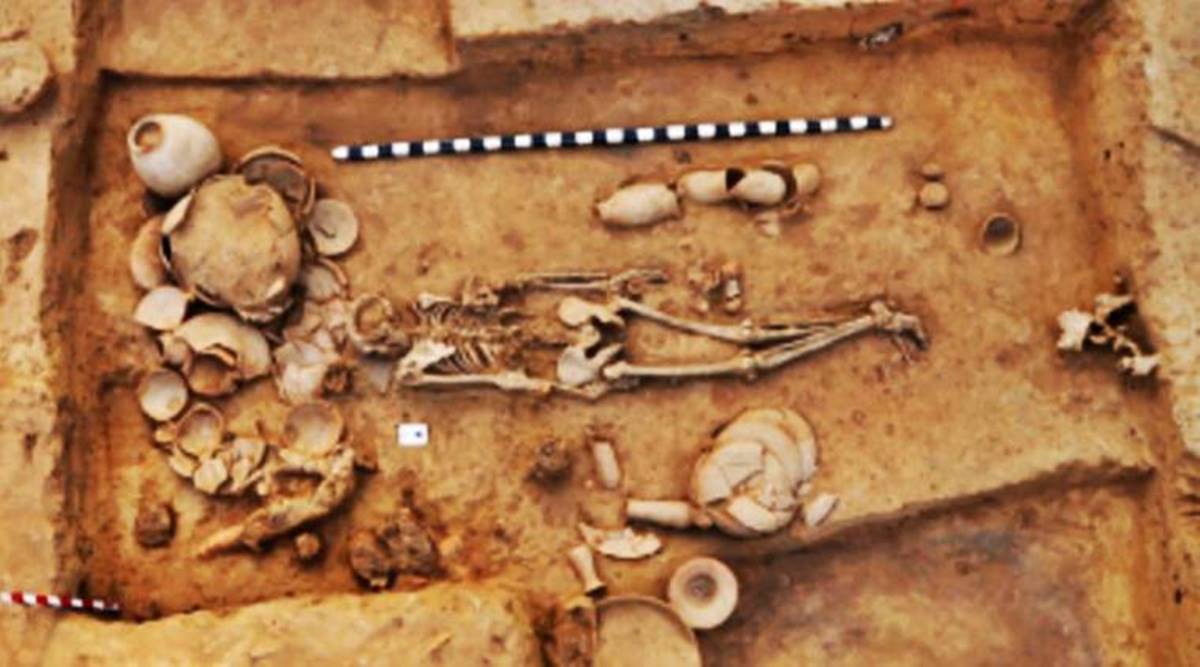A study, titled “Lipid residues in pottery from the Indus Civilisation in northwest India’’ looks at the food habit of the people of that era on the basis of lipid residue analysis found in pottery from Harappan sites in Haryana.
The diet of the people of Indus Valley civilisation had a dominance of meat, including extensive eating of beef, finds a new study published on Wednesday in the ‘Journal of Archaeological Science’.
The study, titled “Lipid residues in pottery from the Indus Civilisation in northwest India’’ and led by Akshyeta Suryanarayan as a part of her PhD thesis at the University of Cambridge, looks at the food habit of the people of that era on the basis of lipid residue analysis found in pottery from Harappan sites in Haryana.
It finds dominance of animal products such as meat of pigs, cattle, buffalo, sheep and goat, as well as dairy products, used in ancient ceramic vessels from rural and urban settlements of Indus Valley civilisation in northwest India – in present-day Haryana and Uttar Pradesh.
The study has been co-authored by former vice-chancellor of Pune’s Deccan College and renowned archaeologist Prof Vasant Shinde and Prof Ravindra N Singh of BHU, as well as with Miriam Cubas, Oliver E. Craig, Carl P. Heron, Tamsin C. O Connell, Cameron A. Petrie of Cambridge University.
How the study was conducted
Indus Valley civilisation was spread across large parts of modern Pakistan, northwest and western India and Afghanistan. The scope of this study concentrates on five villages – Alamgirpur (Meerut, UP), two in Masudpur (Hisar, Haryana), Lohari Ragho (Hisar), Khanak (Bhiwani, Haryana) – as well as Farmana town (in Rohtak district) and Rakhigarhi city (Hisar). Analysis was conducted on 172 pottery fragments recovered from the sites. Ceramic lipid residue analysis provides a powerful means by which foodways of populations can be examined and has been used in a range of archaeological contexts around the world to extract and identify foodstuff within ancient vessels, Suryanarayan said. The study says: “Ceramics are one of the most ubiquitous artefacts recovered during archaeological excavations of proto- and historic South Asian sites. Between 2600–1900 BC, five Indus Civilisation settlements developed into sizable cities, with a range of other medium-sized urban settlements, small settlements with specialised craft production and fortifications as well as rural settlements.” The study also talks of a diversity of plant products and regional variation in cropping practices. Both summer and winter-based cropping was practiced. Evidence of barley, wheat, rice, different varieties of millets, a range of winter and summer pulses, oilseed and fruit and vegetables, including brinjal, cucumber, grapes, date palm were grown and consumed.
Suryanarayan told The Indian Express that while there have been many studies on the food habit in Indus Valley civilisation before, these papers primarily focused on crops grown then. Suryanarayan’s PhD was on “What’s cooking in the Indus Civilisation? Investigating Indus food through lipid residue analysis.’’
“Out of domestic animals, cattle/buffalo are the most abundant, averaging between 50% and 60% of the animal bones found, with sheep/goat accounting for 10% animal remains. The high proportions of cattle bones may suggest a cultural preference for beef consumption across Indus populations, supplemented by consumption of mutton/lamb,’’ says the study.
It says that at Harappa, 90% of the cattle were kept alive until they were three or three-and-a-half years, suggesting that females were used for dairying production, whereas male animals were used for traction.
“Wild animal species like deer, antelope, gazelle, hares, birds, and riverine/marine resources are also found in small proportions in the faunal assemblages of both rural and urban Indus sites suggesting that these diverse resources had a place in the Indus diet,” the study notes. “The pattern is similar at the sites in northwest India, where domestic and wild mammals, and smaller proportions of birds, reptiles, riverine fish, and molluscs were consumed.”
“This study is unique in that it has gotten to look at the contents of the vessels. Normally there would be access to seeds or plant remains. But through the lipid residue analysis, we can confidently ascertain that consumption of beef, goat, sheep and pig was widespread, and especially of beef,’’ said Suryanarayan, 29. lead author of the study who completed her PhD in February and now works with the French National Centre for Scientific Research.
There is also evidence of hares and birds being eaten, although little evidence of chicken being a part of the diet, according to the study. “Ledge-shouldered jars and large storage jars at Harappa have been linked to storage of liquids such as wine and oil,’’ it says.
Prof Shinde told The Indian Express: “There have been two other research papers looking at Indus Valley civilisation meals. The first, published in 2011-12, was by Dr Arunima Kashyap, who first established the presence of curry. She discovered consumption of brinjal, turmeric, garlic and ginger. Then, Dr Kalyan Shekhar Chakraborty established a couple of months ago, from lipid residue investigation from vessels in Gujarat, consumption of goat, sheep and the making of diary products like cheese and paneer, clarified butter and yoghurt.
“Akshyeta’s study takes it a step forward and scientifically proves that this was not only a meat-eating society but a beef- and pork-eating one (as well).”
Shinde said, “We knew that this was probably the case because of the masses of animal bones and remains found, which could not just be through natural causes. But the lipid residue analysis is hard scientific evidence of it.”
Source: Read Full Article


